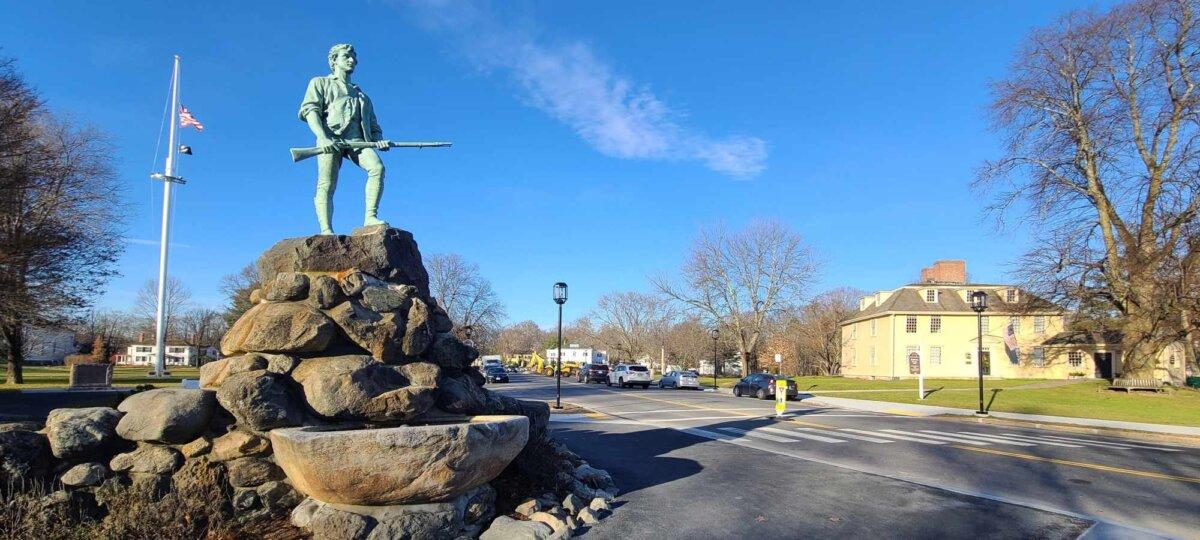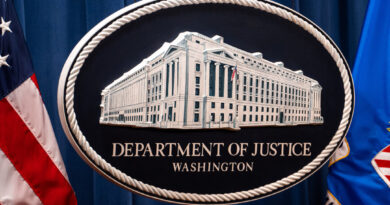Concord and Lexington Commemorate 250 Years Since the Revolutionary War’s ‘Shot Heard Round the World’
The towns in close proximity are forever marked in history as the sites of the initial battles of the American Revolution, although the exact location of the first shot fired remains a topic of contention.
Before daylight broke around 5 a.m. on April 19, bells rang across Lexington Common, drawing hundreds of spectators to witness a reenactment of the skirmish that significantly altered American history 250 years ago.
Lexington and Concord are the two neighboring towns where the first skirmishes occurred between British regular soldiers and colonial militia, commonly referred to as minutemen, who were ready to take action at a moment’s notice.
“On this day, 250 years ago at dawn on April 19, 1775, this common became the cradle of American freedom,” remarked Henry Liu, chair of the Lexington Minute Men reenactment committee, during the April 19 commemoration.
Richard Howell, who portrayed Samuel Tidd, a Lexington minuteman during the battle, described the reenactment as “momentous.”
“This is perhaps one of the most sacred grounds in the nation, if not the entire world, due to what it signifies,” Howell said. “It signifies how a small town like Lexington became a pivotal point in history.”
The Battles of Lexington and Concord ignited an eight-year war that culminated in victory for the colonial troops under the command of Gen. George Washington in September 1783.
Historians concur that the battles, which took place 15 months prior to the Continental Congress signing the Declaration of Independence on July 4, 1776, symbolized the onset of the American Revolution.
A reenactment at dawn was also held on April 19 at Old North Bridge in Concord, roughly seven miles east of Lexington. A monument signifies where it is believed the first British soldier was shot.
An estimated tens of thousands of visitors flocked to the towns to honor this historic day.
A few hundred protestors gathered outside a designated “free speech” zone opposite the Lexington Battle Green, carrying signs with messages seemingly aimed at former President Donald Trump, such as “No King, No Tyranny.”
“We commemorate the memories, recognize the sacrifices, and draw upon the bravery of every liberty hero who valiantly shed blood for the cause of independence on April 19, 1775.”
“In the face of years of increasing tensions and hostility between the British Crown and the American Colonies, all options for peace and diplomacy had been exhausted, and it became evident to the patriots that war was unavoidable. Following the Boston Massacre, the oppressive Intolerable Acts, along with the long-standing grievance of taxation without representation, the colonists began organizing militias as a final recourse in defense of their right to self-governance.”

The Minuteman Statue represents Capt. John Parker, who commanded the Lexington militia during the Battle of Lexington. This statue is found in Minute Man National Historical Park, Concord, Massachusetts.Courtesy of Alan Wakim
Lexington and Concord are etched in history as the birthplace of the American Revolution, although there remains an ongoing debate regarding where the first shot was fired.
“By the rude bridge that arched the flood,
Their flag to April’s breeze unfurled,
Here once the embattled farmers stood
David Wood, curator of the Concord Museum, told NBC Boston on April 14, “If you interpret it literally, you might conclude that Emerson is referring to the firing at the north bridge. However, Emerson’s intent isn’t strictly literal; it’s connected to the North Bridge because that’s where he was situated when he penned the line.”
Lexington Militia Men Captain Steve Cole asserted to NBC that “the first shots of the American Revolution were indeed fired on the Lexington battle green on April 19, 1775.”
Author and historian Alex Cain added that British troops, while marching towards Concord, first encountered colonial militia in Lexington.
“A shot was fired. The identity of the shooter remains unknown. The British claimed it was the Americans, and the Americans claimed it was the British,” Cain shared with NBC.
In March, Concord250 issued a press release inviting the media to Concord to commemorate “the moment when the first shots of the American Revolution were fired at Concord’s Old North Bridge.”
At the time, Boston was the largest city in the 13 colonies. In response to the British Crown’s taxation without representation, colonists in 1773 dumped 342 chests of tea into Boston Harbor, an event known as the Boston Tea Party.
The British Crown, angered by the rebellion, enacted the Intolerable Acts, which closed the Port of Boston, limited the power of colonial governments, and allowed British troops to be quartered in private residences.
Tensions heightened with the arrival of British warships and soldiers, known as regulars.
Future founding fathers John Hancock and Samuel Adams were forced to flee Boston and head to the Massachusetts countryside. By early 1775, the British controlled areas around Boston while the rest of Massachusetts was in rebellion.
General Thomas Gage, serving as the Royal Governor of Massachusetts, led the British forces stationed in the colony.
Receiving intelligence from British spies, Gage ordered 700 soldiers to march to Concord on April 18, 1775, to dismantle a stockpile of military supplies.

Paul Revere visited Rev. Jonas Clarke’s residence to warn John Hancock and Samuel Adams about the advancing British troops. He urged them to flee without delay.Courtesy of Alan Wakim
In Lexington, Revere and Dawes encountered Dr. Samuel Prescott, who volunteered to accompany them. Prescott was the only one of the three Midnight Riders to reach Concord successfully.
Three miles west of Lexington, halfway to Concord, the trio was ambushed by a British patrol. While Dawes and Prescott managed to escape, Revere was captured.
Revere informed his captors that the towns were aware of their mission and had mobilized their militias. Distant bells and musket fire confirmed his warning.
Dawes’ journey ended abruptly when he fell from his horse. Prescott escaped and made it to Concord around 1:30 a.m., where he notified a sentry, who rang the bell at Concord First Parish Church to alert the town.
Revere returned to Lexington on foot and urged Hancock and Adams to flee.
Meanwhile, Captain John Parker of the Lexington Militia gathered his company on the town green. The militiamen—who wore no uniforms and received no pay—were composed of blacksmiths, farmers, shopkeepers, and schoolteachers.
Drenched British troops crossed the Charles River and commenced their 16-mile march to Concord.
British forces confronted the Lexington militia on the Lexington Green around 5 a.m. The precise events of that morning remain unclear. Outnumbered, Parker’s men withdrew. A gunshot from an undetermined source rang out, prompting British troops to unleash a volley of shots.
The conflict in Lexington resulted in the death of eight colonists and injuries to 10 others. The British troops, unharmed, continued their march towards Concord.
Meanwhile, Prescott and Reuben Brown, an alarm rider stationed in Lexington, hurried to Concord to inform the town about the shots fired in Lexington. The militia and minutemen in Concord readied themselves for the British forces.
The alarm spread to farms, fields, and villages, prompting minutemen to converge on Concord.
Outnumbered again, the colonial militia retreated across the North Bridge, withdrawing from the town center. Seven companies of British regulars crossed the bridge to search a house for arms and military supplies.
From their elevated position, colonial soldiers observed smoke rising from Concord as the British were burning the supplies they had discovered. Believing the town was under attack, 400 colonial soldiers marched towards the North Bridge, outnumbering the three British companies guarding the crossing.
Shots were fired from the British side, followed by Concord’s Major John Buttrick ordering the militiamen to return fire. This marked the first occasion in which colonial soldiers were commanded to engage British troops.
Three British soldiers and nine others were injured in a volley that would become known as “the shot heard round the world.”
The British soldiers retreated back to Boston, marking Concord as the site of the first colonial victory in this newly ignited American Revolution.
During their retreat, swarms of colonists took positions behind the stone walls, trees, and buildings along what is now known as Battle Road, firing at the British troops, creating a perilous gauntlet for the 700 British regulars.
In Lexington, Parker and his men sought retribution by opening fire on the British regulars. Throughout their journey back to Boston, British regulars faced ambushes from minutemen positioned on both sides of the road.
By the time they returned to Boston, reports indicated that the British had suffered losses exceeding one third of their force.
While the location of the first shot remains disputed, the events in Lexington and Concord rallied support for the colonial militia.
Pulitzer Prize-winning historian Stacy Schiff, known for her biographies of Benjamin Franklin and Samuel Adams, noted that Lexington and Concord “galvanized public opinion just as the Massachusetts men had hoped it would, yet the path to a vote for independence was still long, a sentiment that Adams felt should have been declared on April 20, 1775.”
“Once shots were fired in Lexington, Samuel Adams and Joseph Warren took every measure to collect testimonies from witnesses and disseminate them swiftly; it was crucial for the colonies and the world to know who had fired first,” Schiff elaborated.
“Adams was convinced that the skirmish at Lexington would be ‘legendary in the history of this country.’ He worked tirelessly to clarify who the aggressors had been.”
The Associated Press contributed to this report.




